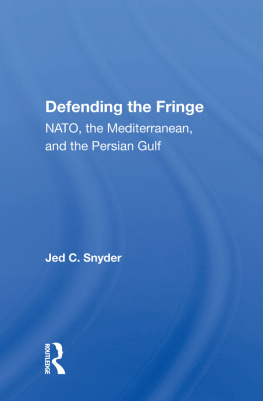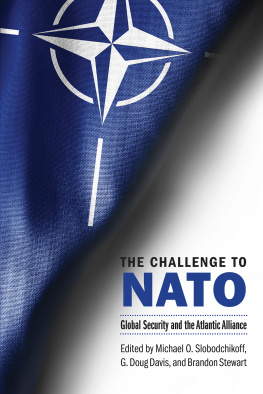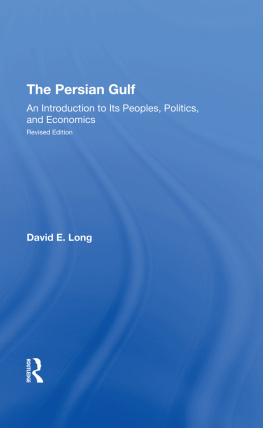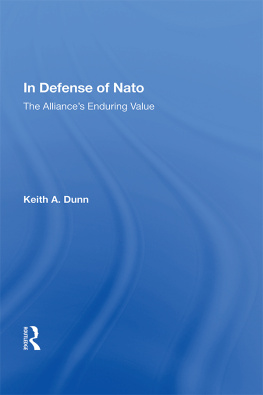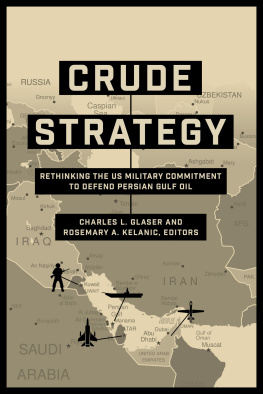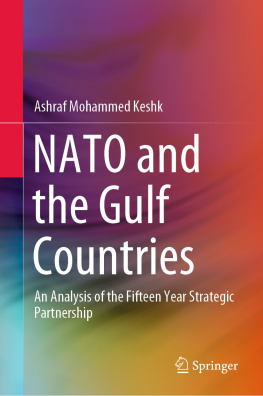Defending the Fringe
THE JOHNS HOPKINS FOREIGN POLICY INSTITUTE
Harold Brown
Chairman
Simon Serfaty
Executive Director
Robert E. Osgood
Codirector Security Studies Program
Wilfrid Kohl
Director international Energy Program
Philip Geyelin
Editor-in-Residence
Michael Vlahos
Codirector Security Studies Program
Nancy McCoy
Editorial Coordinator
George R. Packard
Dean, School of Advanced International Studies, The Johns Hopkins University
The Johns Hopkins Foreign Policy Institute (FPI) was founded in 1980 and serves as the research center for the School of Advanced International Studies (SAIS) in Washington, D.C. The FPI is a meeting place for sais faculty members and students as well as for government analysts, policymakers, diplomats, journalists, business leaders, and other specialists in international affairs. In addition to conducting research on policy-related international issues, the FPI sponsors conferences, seminars, and roundtables.
The FPI's research activities are often carried out in conjunction with SAIS's regional and functional programs dealing with Latin America and the Caribbean Basin, U.S. foreign policy, U.S.-Japan relations, Canada, Africa, Europe, security studies, international energy, and international economics.
FPI publications include the SAIS Review, a biannual journal of foreign affairs, which is edited by SAIS students; the SAIS Papers in International Affairs, a monograph series copublished with Westview Press in Boulder, Colorado; and the FPI Policy Briefs, a series of analyses of foreign-policy issues as they develop.
For additional information regarding FPI publications, write to: FPI Publications Program, School of Advanced International Studies, The Johns Hopkins University, 1740 Massachusetts Avenue, N.W., Washington, D.C. 20036.
About the Book and Author
The Soviet Union's gradual but steady accumulation of military power and its consequent evolution as a global strategic actor have affected Western postwar theorems of East-West policy and European security. These paradigms were founded on the assumption that central Europe would remain the primary target for Soviet political-military pressure. Deterring NATO-Warsaw Pact conflict on the central front, therefore, has been the overriding concern of Western security policy. Today, however, Soviet ability to project military power far from its shores has created a new set of geopolitical realities.
Jed Snyder argues that the strategic center of East-West policy may be shifting to "fringe" areasregions outside central Europe where political-military and economic weakness have created strategic vulnerabilities for the Western Alliance. Although the Soviets will continue to pressure NATO's center (principally West Germany), Moscow can be expected to focus increasing attention on the Mediterranean basin, where the position of the Alliance is deteriorating. Soviet naval and air power have expanded over the entire southern flank at the same time that a discernible erosion of "strategic partnership" has occurred among the five NATO flank statesTurkey, Greece, Italy, Portugal, and Spain. Indigenous sources of sociopolitical instability in the Persian Gulf, the lack of support among gulf states for an effective defense association, and the region's great strategic value for both superpowers suggest that the Persian Gulf may now become a more likely theater of East-West conflict.
The increased strategic importance of these fringe areas creates the need for a Western strategy designed to respond to political-military threats in regions where the comparative investment of the West is dwarfed by that of its adversaries. In this book Jed Snyder examines the sources of Western strategic decline on the southern fringe and calls for a strategy designed to strengthen allied capability to meet a range of security threats.
Jed C. Snyder is deputy director of national security studies and Herman Kahn Fellow at the Hudson Institute. He was senior special assistant to the director of politico-military affairs at the Department of State during the first Reagan administration.
NUMBER 11
SAIS PAPERS IN INTERNATIONAL AFFAIRS
Defending the Fringe
NATO, the Mediterranean, and the Persian Gulf
Jed C. Snyder
The Security Studies Program
First published 1987 by Westview Press, Inc.
Published 2018 by Routledge
52 Vanderbilt Avenue, New York, NY 10017
2 Park Square, Milton Park, Abingdon, Oxon OX14 4RN
Routledge is an imprint of the Taylor & Francis Group, an informa business
Copyright 1987 by The Johns Hopkins Foreign Policy Institute, School of Advanced International Studies (SAIS)
All rights reserved. No part of this book may be reprinted or reproduced or utilised in any form or by any electronic, mechanical, or other means, now known or hereafter invented, including photocopying and recording, or in any information storage or retrieval system, without permission in writing from the publishers.
Notice:
Product or corporate names may be trademarks or registered trademarks, and are used only for identification and explanation without intent to infringe.
Library of Congress Cataloging-in-Publication Data
Snyder, Jed C.
Defending the fringe.
Includes index.
(SAIS papers in international affairs; no. 11)
1. North Atlantic Treaty Organization. 2. Mediterranean RegionDefenses. 3. Persian Gulf RegionDefenses. I. Title. II. Series.
UA646.3.S64 1987 355'.031'091821 86-11182
ISBN 13: 978-0-367-00669-3(hbk)
Contents
, Michael Vlahos
Part 1
NATO and the Mediterranean: Southern Flank Security and the Decline of Strategic Partnership
Part 2
U.S. and Allied Security Policy in the Persian Gulf: Options and Dilemmas
- AAM Air-to-air Missile
- ACE AMF Allied Command Europe Mobile Force
- AEW Airborne Early Warning
- AFSOUTH Allied Forces Southern Europe
- AIRSOUTH Allied Air Forces Southern Europe
- ASM Air-to-surface Missile
- ASW Antisubmarine Warfare
- AWACS Airborne Warning and Control System
- CENTCOM U.S. Central Command
- CENTO Central Treaty Organization
- CINCEUR Commander in Chief, United States Forces, Europe
- CINCSOUTH Commander in Chief, Allied Forces Southern Europe
- CNO Chief of Naval Operations
- COMAIRSOUTH Commander, Allied Air Forces Southern Europe
- COMNAVSOUTH Commander, Allied Naval Forces Southern Europe
- COMSIXATAF Commander, Sixth Allied Tactical Air Force
- CINCUSNAVEUR Commander in Chief, U.S. Naval Forces Europe
- DECA Defense and Economic Cooperation Agreement
- DEFCON Defense Condition
- DOD Department of Defense
- EEC European Economic Community
- FIR Flight Information Region
- FIVEATAF Fifth Allied Tactical Air Force
- FOB Forward Operating Base
- GCC Gulf Cooperation Council
- GLCM Ground-launched Cruise Missile

